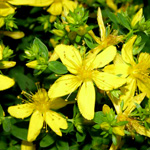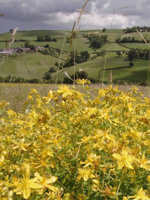St. Johnswort
Hypericum perforatum
family:Clusiaceae

the plant: Blooms around summer solstice in Sonoma. A perennial 1-3 foot herb with a woody base, found in disturbed soil & full sun. Branching upper stems end in bright yellow five-petalled 1-2" flowers with tiny black dots, three long styles and three bundles of stamens emerging in a spray from the center. Native to Europe, West Asia, North Africa, Madiera & Azores but now grows wild abundantly in North America and Australia.
parts used: flowering tops.
medicinal actions: cooling nervine tonic, pain sedative, antispasmodic, vulnerary, astringent, anti-inflammatory, anti-bacterial & anti-viral.
indications: This herb comes to the rescue for raw nerves and wounds of flesh. It calms anxiety, melancholy and tension of the mind, nerves and body, as well as menopausal irritability. Externally, its antiseptic astringency aids healing of flesh wounds like sores, cuts, bruises, burns, hemorrhoids & varicose veins, and helps to calm swelling, stop bleeding & prevent infection, especially with weak immunity. It is also useful externally for sciatica, arthritis, spine ailments & fybromyalgia - anything 'nervy'. Long thought to chase off harmful spirits and offer light.
contraindications: Some studies suggest that it interferes with certain drugs such as oral contraceptives or anti-depressants. Hypericin chemical extract causes people to be sensitive to sunlight, whole plant can do the same for grazing animals.
preparation: tincture & infused oil, which both become deep red as the herb steeps. powdered dry herb on wounds.
note: This information is not a replacement for a trained herbalist. Please consult your medical professional before treating yourself or others with this or any other herbal remedy.